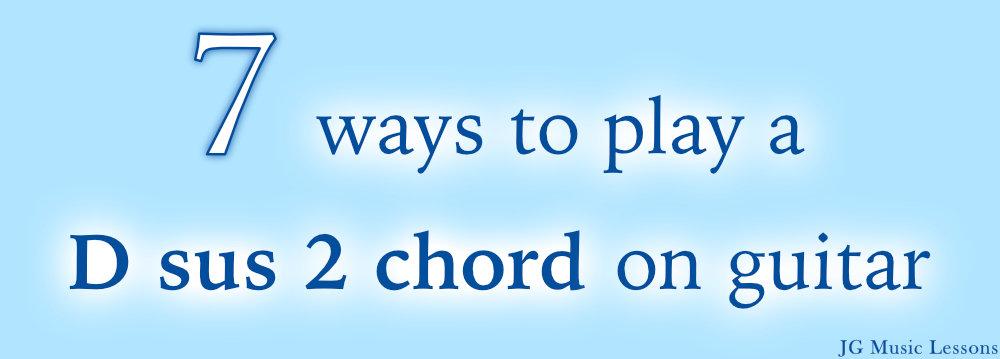After mastering your basic chords on guitar, you’ll also want to learn sus 2 chords which often come up in many popular songs. These chords have a cool, airy, open sound that will freshen up progressions. In this lesson, we’ll specifically be covering how to play the D sus 2 chord, which is short for “Suspended 2”.
This chord has an easy open shape but there are many different ways you can play it throughout the guitar fretboard. By knowing different chord variations, you’ll be able to use them in different musical contexts.
We’ll first go over some basic chord theory and then show you 7 ways to play a D sus 2 chord on guitar. Let’s get started!
D sus 2 chord theory
“Suspended 2” chord means that the 2nd degree replaces the 3rd of the chord. For example, a Major triad chord has the chord tones 1, 3, and 5, but a sus 2 chord has chord tones 1, 2, and 5.
This means that a D sus 2 chord has the chord tones D, E, and A.
Here is the formula for sus 2 chords below.
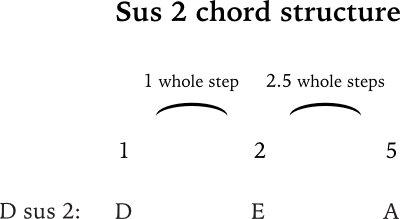
To compare, here are the notes for other chords with D as the root.
- D Major chord has the notes D, F#, and A.
- D minor chord has the notes D, F, and A.
If needed, check out this other post to understand the difference between sus 2 chords and add 2 chords.
Now that you know what notes belong to the chord structure, let’s look at how to read the chord charts.
How to read the chord charts
For the charts below:
- The top horizontal line of the chord chart represents the high E string and the bottom horizontal line represents the low E string.
- The vertical lines separate each fret.
- The numbers in the blue dots tell you which fingers to use on the fretting hand.
- The letters on the right of the charts tell you what notes you are playing on each string.
- Circles on the left represent open strings.
- Red X means to avoid that string.
You can check this link for more on how to read guitar notation symbols.
D sus 2 chord – open shape
An easy way to play the D sus 2 chord is to use the following open chord shape with only two fretted notes on the 3rd and 2nd string.
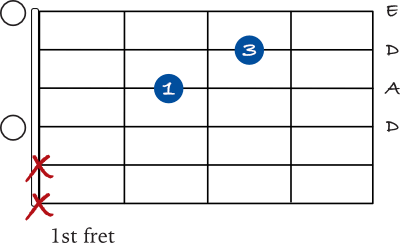
D sus 2 chord – 4th string
Here is another way to play this chord with the open 4th string using your 1st, 2nd, and 3rd finger. This variation may be more suitable for a finger picking style because of the gap between strings used.

D sus 2 mini barre chord – 4th string
For this chord, we use a mini barre to cover the first two strings on the 5th fret.
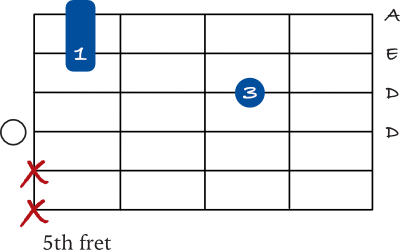
We’ll use this shape as the foundation for the next full barre chord shape.
D sus 2 barre chord – 5th string
This next D sus 2 chord uses a barre on the 5th string. This shape comes from shifting the open A sus 2 chord. You would barre the 5th fret and add the notes on 7th fret (3rd and 4th strings). This shape looks like a power chord, except you are also barring with your first finger.
If you can’t get the chord to sound clear, first try to get the notes from the 5th to the 2nd fret. As you develop more strength in your fingers, try adding the 1st string as well.
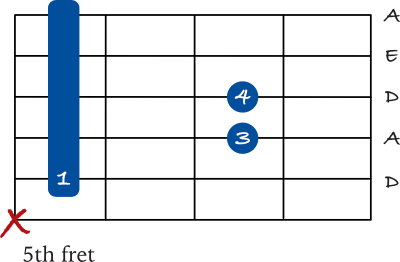
If needed, you can check out these 5 tips to get better at playing barre chords.
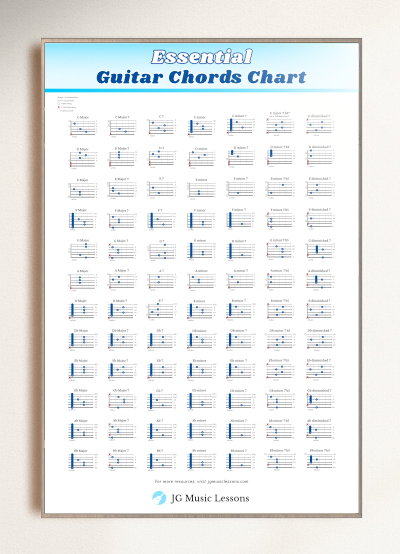
D sus 2 chord 2nd inversion – 5th string
This next D sus 2 chord is in 2nd inversion, which means that the 5th of the chord is the bass note. This chord shape can be more difficult because it requires a wide stretch between your 1st and 4th finger.
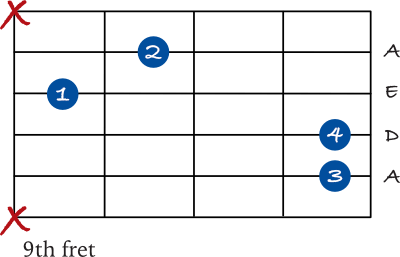
This shape originally comes from the open F sus 2 chord in 2nd inversion, starting on the 5th string.
D sus 2 chord on the 6th string
The following chord shape can also be trickier to play because of the wide stretch between your fingers. This variation would be more suitable for a rock style because of the way the notes are arranged in the lower strings.
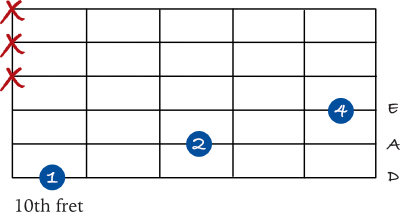
You can also use this same shape starting on the 5th string, 5th fret while avoiding the strings that are not fretted.
D sus 2 chord- 6th string variation
This last D sus 2 chord shape also has wide stretches between your fingers which can be challenging to play at first. This shape comes from shifting the open G sus 2 chord.
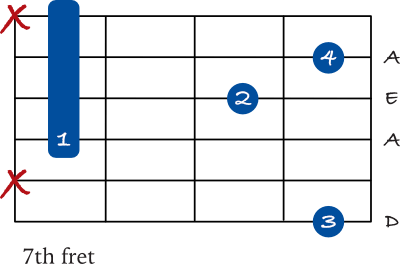
Wrapping up
Sus 2 chords sound great as replacements or embellishment for Major chords to create an open sound. Try replacing these chords to add a little twist to chord progressions you already know. Experiment to get a feel for how these chords work best.
It’s good to know different variations of playing sus 2 chords because you have more flexibility to move around the fretboard and also when you need a specific note in the top to help define a melody that you are playing over.
I hope this helped you understand how to play a D sus 2 guitar chord or learn new ways of playing it. You can also try shifting the shapes that have all fretted notes to play other sus 2 chords on the same string.
📘 Get the free guitar practice guide here!
All the best,
JG Music Lessons
Start Playing Better, Faster
by becoming a Pro Member! ✨
Transform your playing by enjoying benefits such as:
• 📙 Exclusive Lesson PDFs and Ebooks
Get access to a growing library of clear, downloadable resources—save time and skip the clutter.
• 🎼 Full Song Lessons
Break down your favorite songs step by step, and play them with confidence.
• 🚫 Ad-Free Learning
Focus better with a distraction-free environment.
• 🎁 Store Discounts
Save 50% off on all song PDFs, charts, audio tracks, bundles, and design printables.
• 💬 Member Support
Got questions? We’ve got your back, helping you stay on track!
👉 Join Here!
Level up with the FREE guitar practice guide and effectively improve your playing! 🎸
Get it sent to your email!

